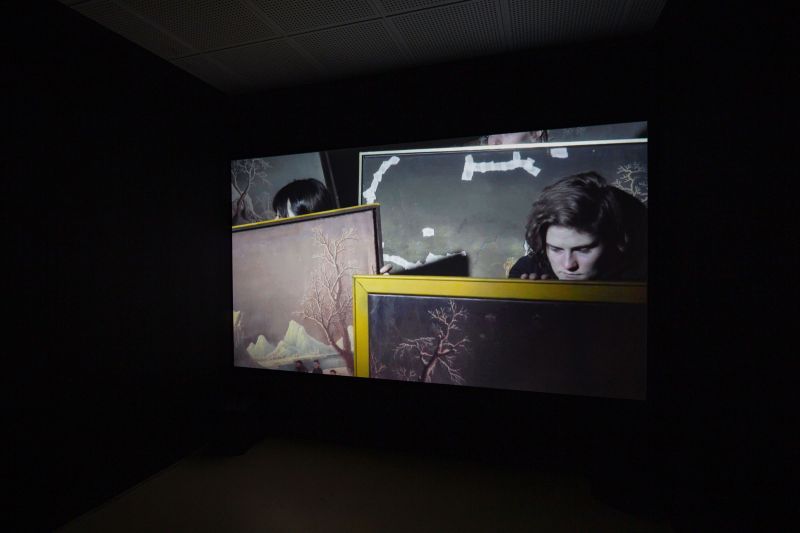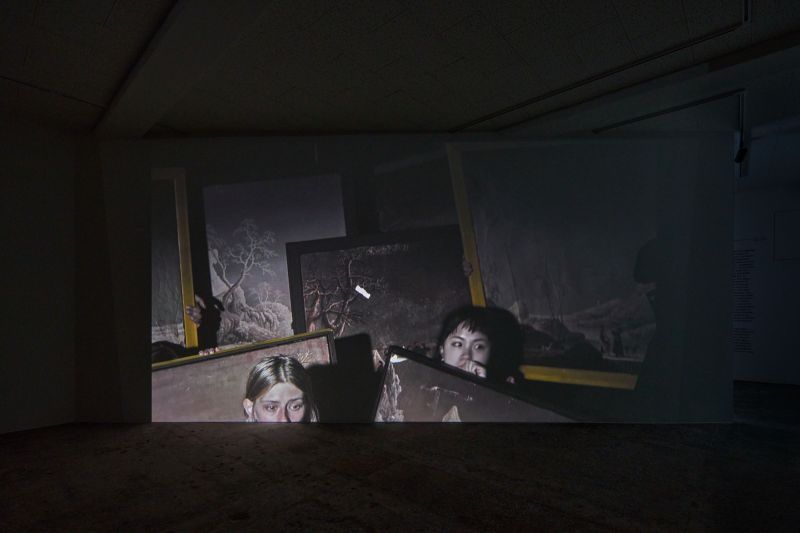Excerpt, A dissonance of Landscapes. Film, colour, sound, 23 min.
A Dissonance of Landscapes
(2019)
On one summer’s night in Amsterdam, “Ten Export Winter Landscapes” were removed from the dark archives of the Tropenmuseum and were dispersed into the shadowy corners of the city. Ten performers on a precarious boat, each carrying a winter landscape oil painting, journeyed into the sea from the IJ. Because these winter landscape paintings were made in Canton, where there is no such winter, Cantonese painters were imagining wintery seasons based on small drawings and prints from Europe. Cantonese painters and attributed to their tropical region, the imagination behind them is a result of an exchange between the Dutch and the Cantonese in the 19th century. Intended to be sold in the Netherlands, they become not only souvenirs of the exotic but also a conversation between two contexts in different climates, collaged into one heterogeneous scene. The act re-performs this historical narrative along unstable waters and illumination, in between movement and stillness. What is at stake here are questions of cultural authority in the representation of histories constructed through diasporic movements.

Image documentation of the installation from the exhibition Elsewheres Within Here, curated by Jo‑Lene Ong at Framer Framed, Amsterdam, NL, 2019. © Maarten Van Haaff.

Exhibition view of the 2024 K-Arts space Opening Exhibition 𝑻𝒉𝒊𝒔 𝒏𝒂𝒎𝒆𝒍𝒆𝒔𝒔 𝒔𝒊𝒕𝒆𝒔. Photo: Dongwoong Lee.
“Ten winter landscape paintings gently bob up and down against the night sky, held up by young women and men, whose earnest faces peer over the damaged surfaces of the canvases. This barely moving vignette is the focus of Aram Lee’s video A Dissonance of Landscapes (2019), whose location on a boat is discernible only from the sound of water and the distant hum of an engine. The moving vessel is rendered invisible, lending a certain abstraction to this unspoken conversation between static objects and people. We are left to imagine the dark stillness of the surrounding landscape and to scan the paintings’ imagery for clues about the significance of this obscure nocturnal event.
The frozen terrains depicted in the paintings are reminiscent of Northern Europe, yet there is something about the stylized frills of the rock formations, the flattened rendering of the human figures, and the translucent quality of the white vistas that make it impossible to securely identify the works. Rather, in being “almost but not quite” Dutch or Flemish, Scandinavian or Germanic, they reveal their status as something “other.” Excavated by the artist from the archives of Amsterdam’s Tropical Museum, built as an ode to its colonial exploits, these are Cantonese paintings from the 1800s, made by artists living in a subtropical region. These depicted winter scenes are forged by imagination as well as being informed by traditional Chinese repertoires, and by prints and drawings brought by Dutch traders. Their heterogeneous landscapes are not fictitious representations; they bear witness to an intercultural imaginary, to a conversation still waiting to be heard.
In Lee’s video, these “ten export landscapes” are taken on a precarious journey from Amsterdam’s IJ channel to the open sea. Instead of telling us “about” histories of Dutch-Chinese trade and uneven cultural exchange, she plunges us into an underexamined space between centuries and continents; a tale whose neglect is materially manifest in the paintings’ cracked and roughly taped surfaces. The darkness of the scene intimates that this space is located in the mind as much as in material reality. We become fellow travelers in this imagined geography, not knowing our destination, but experiencing how the journey unfixes stable markers. We notice that certain occupants of the boat have Asian features, echoing the physical presence of the Chinese painters whose names have gone unrecorded, while the gait and physique of other passengers might have stepped out of a Rembrandt painting, reminding us that the genealogies of colonial histories lead to the present. Yet all of the boat’s occupants are familiar with the lights of Amsterdam and the low bridges the boat must traverse on its way. Self-contained histories do not exist here, only entwined lives, past and present. There is no “arrival” to or from a fixed point, only the constant inextricable journeying of cultures and peoples; an acknowledgment that begs for a redistribution of cultural capital. […]”¹
Footnotes:
- Excerpt from Unknowing Culture, a text by Lucy Cotter featured in the book Persistent Traces from Heritage to Come aud published by Suns and Stars, Amsterdam, 2020.
A Dissonance of Landscapes was supported by the Amsterdams Fonds voor de Kunst, and has been commissionned and presented at Framer Framed, Amsterdam, NL, 2019.